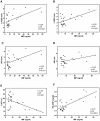Elevated serum levels of macrophage migration inhibitory factor are associated with progressive chronic cardiomyopathy in patients with Chagas disease
- PMID: 23451183
- PMCID: PMC3579792
- DOI: 10.1371/journal.pone.0057181
Elevated serum levels of macrophage migration inhibitory factor are associated with progressive chronic cardiomyopathy in patients with Chagas disease
Abstract
Clinical symptoms of chronic Chagas disease occur in around 30% of the individuals infected with Trypanosoma cruzi and are characterized by heart inflammation and dysfunction. The pathogenesis of chronic chagasic cardiomyopathy (CCC) is not completely understood yet, partially because disease evolution depends on complex host-parasite interactions. Macrophage migration inhibitory factor (MIF) is a pleiotropic proinflammatory cytokine that promotes numerous pathophysiological processes. In the current study, we investigated the link between MIF and CCC progression.Immunohistochemical analysis demonstrated MIF overexpression in the hearts from chronically T. cruzi-infected mice, particularly those showing intense inflammatory infiltration. We also found that MIF exogenously added to parasite-infected murine macrophage cultures is capable of enhancing the production of TNF-α and reactive oxygen species, both with pathogenic roles in CCC. Thus, the integrated action of MIF and other cytokines and chemokines may account for leukocyte influx to the infected myocardium, accompanied by enhanced local production of multiple inflammatory mediators. We further examined by ELISA the level of MIF in the sera from chronic indeterminate and cardiomyopathic chagasic patients, and healthy subjects. CCC patients displayed significantly higher MIF concentrations than those recorded in asymptomatic T. cruzi-infected and uninfected individuals. Interestingly, increased MIF levels were associated with severe progressive Chagas heart disease, in correlation with elevated serum concentration of high sensitivity C-reactive protein and also with several echocardiographic indicators of left ventricular dysfunction, one of the hallmarks of CCC. Our present findings represent the first evidence that enhanced MIF production is associated with progressive cardiac impairment in chronic human infection with T. cruzi, strengthening the relationship between inflammatory response and parasite-driven pathology. These observations contribute to unravel the elements involved in the pathogenesis of CCC and may also be helpful for the design of novel therapies aimed to control long-term morbidity in chagasic patients.
Conflict of interest statement
Figures



Similar articles
-
MIF-driven activation of macrophages induces killing of intracellular Trypanosoma cruzi dependent on endogenous production of tumor necrosis factor, nitric oxide and reactive oxygen species.Immunobiology. 2017 Feb;222(2):423-431. doi: 10.1016/j.imbio.2016.08.007. Epub 2016 Aug 28. Immunobiology. 2017. PMID: 27591076
-
CCL3/Macrophage Inflammatory Protein-1α Is Dually Involved in Parasite Persistence and Induction of a TNF- and IFNγ-Enriched Inflammatory Milieu in Trypanosoma cruzi-Induced Chronic Cardiomyopathy.Front Immunol. 2020 Mar 3;11:306. doi: 10.3389/fimmu.2020.00306. eCollection 2020. Front Immunol. 2020. PMID: 32194558 Free PMC article.
-
The combined action of glycoinositolphospholipid from Trypanosoma cruzi and macrophage migration inhibitory factor increases proinflammatory mediator production by cardiomyocytes and vascular endothelial cells.Microb Pathog. 2022 Dec;173(Pt A):105881. doi: 10.1016/j.micpath.2022.105881. Epub 2022 Nov 12. Microb Pathog. 2022. PMID: 36379373
-
Inflammation and mitochondria in the pathogenesis of chronic Chagas disease cardiomyopathy.Exp Biol Med (Maywood). 2023 Nov;248(22):2062-2071. doi: 10.1177/15353702231220658. Exp Biol Med (Maywood). 2023. PMID: 38235691 Free PMC article. Review.
-
The Oxidative Stress and Chronic Inflammatory Process in Chagas Disease: Role of Exosomes and Contributing Genetic Factors.Oxid Med Cell Longev. 2021 Dec 23;2021:4993452. doi: 10.1155/2021/4993452. eCollection 2021. Oxid Med Cell Longev. 2021. PMID: 34976301 Free PMC article. Review.
Cited by
-
Cytokine Networks as Targets for Preventing and Controlling Chagas Heart Disease.Pathogens. 2023 Jan 21;12(2):171. doi: 10.3390/pathogens12020171. Pathogens. 2023. PMID: 36839443 Free PMC article. Review.
-
Trypanosoma cruzi P21: a potential novel target for chagasic cardiomyopathy therapy.Sci Rep. 2015 Nov 17;5:16877. doi: 10.1038/srep16877. Sci Rep. 2015. PMID: 26574156 Free PMC article.
-
The Role of MIF and IL-10 as Molecular Yin-Yang in the Modulation of the Host Immune Microenvironment During Infections: African Trypanosome Infections as a Paradigm.Front Immunol. 2022 Apr 7;13:865395. doi: 10.3389/fimmu.2022.865395. eCollection 2022. Front Immunol. 2022. PMID: 35464430 Free PMC article. Review.
-
Risk Factors for Progression to Chronic Chagas Cardiomyopathy: A Systematic Review and Meta-Analysis.Am J Trop Med Hyg. 2023 Feb 27;108(4):791-800. doi: 10.4269/ajtmh.22-0630. Print 2023 Apr 5. Am J Trop Med Hyg. 2023. PMID: 36848894 Free PMC article.
-
Role of Chemokines and Trafficking of Immune Cells in Parasitic Infections.Curr Immunol Rev. 2013;9(3):157-168. doi: 10.2174/1573395509666131217000000. Curr Immunol Rev. 2013. PMID: 25383073 Free PMC article.
References
-
- Pan American Health Organization (2009) Joint Meeting of Southern Cone, Central American, Andean, Amazon and Mexican Subregional Initiatives for the Prevention and Control of Chagas' disease PAHO, dichlorodihydrofluorescein diacetate, Brazil.
-
- Rassi A Jr, Rassi A, Little WC, Xavier SS, Rassi SG, et al. (2006) Development and validation of a risk score for predicting death in Chagas' heart disease. N Engl J Med 355: 799–808. - PubMed
-
- Biolo A, Ribeiro AL, Clausell N (2010) Chagas cardiomyopathy--where do we stand after a hundred years? Prog Cardiovasc Dis 52: 300–316. - PubMed
-
- Marin-Neto JA, Cunha-Neto E, Maciel BC, Simões MV (2007) Pathogenesis of chronic Chagas heart disease. Circulation 115: 1109–1123. - PubMed
-
- Higuchi ML, Benvenuti LA, Reis MM, Metzger M (2003) Pathophysiology of the heart in Chagas' disease: current status and new developments. Cardiovasc Res 60: 96–107. - PubMed
Publication types
MeSH terms
Substances
Grants and funding
LinkOut - more resources
Full Text Sources
Other Literature Sources
Medical
Research Materials
Miscellaneous

